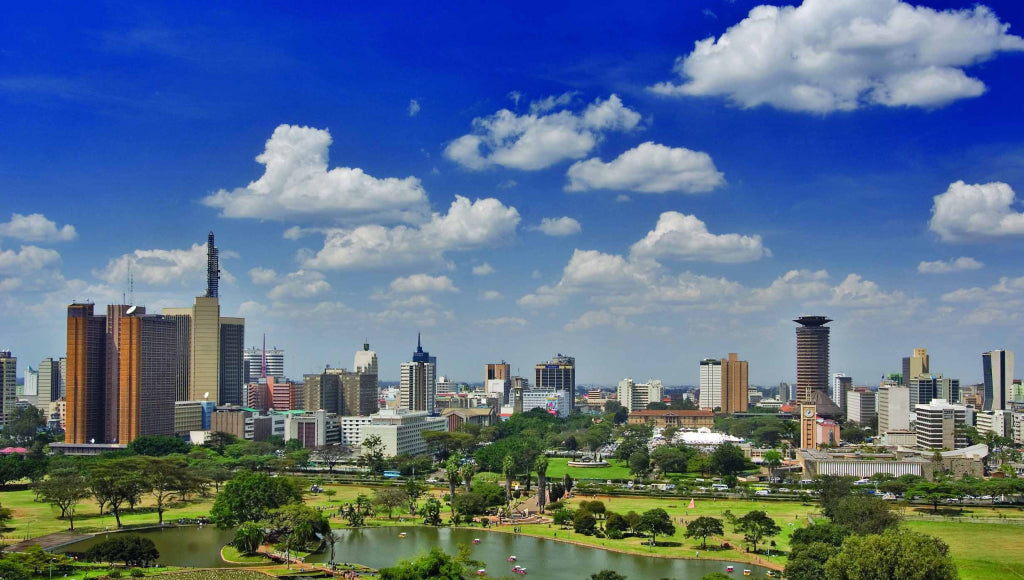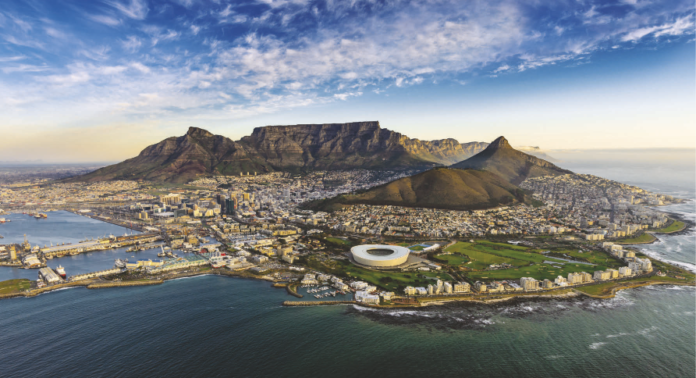10 Largest Cities in Africa

Africa is both a developing and an underdeveloped continent, despite its immense natural wealth.
While no Africa city ranks among the top ten largest cities in the world, Africa retains the title of the continent experiencing the world’s fastest rate of urbanization. 1
Ranking Africa's Largest Cities
There is no absolute clear-cut way of determining the largest city. However, we have given metro population as the leading indicator followed by land area - then regional influence, and lastly, infrastructure.
Note: Population stats are from actual censuses conducted as well as credible projections or forecasts.
Related: 10 Must Visit Beautiful African Islands
10. Nairobi, Kenya

Nairobi is the capital city of Kenya.
The population: Nairobi's metro is about 6.54 million people, occupying a land area of about 696 square kilometers (or 269 square miles).
Green city: The city holds the reputation of being “green city in the sun”, Nairobi is the only capital city in the world that is home to an expansive game reserve - the Nairobi National Park.
It is not uncommon to encounter stray wild animals on the road, especially lions and warthogs. With a pair of binoculars, you can easily peep through the national park while on nearby tall buildings.
Apart from lions and warthogs, you can easily see giraffes, zebras, leopards, antelopes, and so many other Savannah grassland species. The national park is a walking distance from the Capital city and the main airport – Jomo Kenyatta International Airport (JKIA).
Nairobi boasts of being the largest city economy in Central and East Africa. It has vibrant commerce and technology hubs.
9. Luanda, Angola

Luanda, formerly named São Paulo da Assunção de Loanda. It is the capital city of Angola and home to a metro population of 6.94 million people according to data provided by the National Statistics Bureau in 2014.
Rapid growth: However, being the fastest growing city in Africa in terms of population growth rate, it is estimated to reach 9 million residents by 2030.
Luanda is a busy seaport where the bulk of the country’s exports pass through. Some of the leading exports include oil, iron ore, diamonds, and fish. It's leading imports include iron (the irony of exporting iron ore to import iron and steel), steel, machinery, coal, among others.
Inequality: Luanda has the reputation of being the most expensive city to live in not only in Africa but also in developing countries. Despite huge natural wealth, the poverty level in Angola's biggest city is at about 53%; thus contributing high-level crimes in the city.
8. Cape Town, South Africa

Cheers: While Johannesburg is famously known as the 'City of Gold', Cape Town is famously known as the ‘City of Wine’ due to the many vineyards in the surrounding lands.
Cape Town is famed for its beautiful landmarks including the famous Table Mountain and natural harbors. It is perhaps one of the leading cities that attracts most tourists in South Africa. Cape Town is home to about 4 million people (as of the 2011 official census).
7. Alexandria, Egypt

Alexandria has a population of over 4 million people.The city is Egypt’s second largest city after Cairo, however, it's the country's largest industrial hub and the oil export hub.
Alexandria is famously known as the ‘Pearl of Mediterranean’ due to its great location along the Mediterranean Sea and its fair climate with great beaches.
Naturally, this beauty attracts millions of tourists from around the world, especially Europe.
6. Dar es Salaam, Tanzania

Dar has a population of about 4.36 million people covering a land area of about 1,393 square kilometers (or 538 square miles). The former capital city of Tanzania and its largest city, Dar es Salaam lives to the true meaning of its name as “the place of peace.”
Apart from being the place of peace, Dar (as fondly called) is the world’s Swahili capital. It is the city with the highest Swahili speaking population in the world. Swahili is the lingua franca of most countries in the East and Central Africa and parts of the Middle East (Yemen and Oman).
Dar is the largest port along the east coast of Africa and serves several landlocked countries in Africa including Uganda, Rwanda, Burundi, and DRC.
5. Abidjan, Ivory Coast

Abidjan has a population of about 4.7 million people with a land coverage of about 2,119 square kilometers (or 818 square miles).
Abidjan has the reputation of being Africa’s Paris, and it is a city with the third highest French-speaking population in the world. Trailing only Paris and Kinshasa.
Taste of French Culture: It is the leading French cultural center outside of France. Popularly known as the “Manhattan of the Tropics”, Abidjan is the old capital city of Ivory Coast.
It is a popular tourist destination in West Africa and a melting pot of cultures with the more flamboyant and expressive French culture having taken deep roots. The greatest tourist attractions in Abidjan are the white sand beaches, Park Du Banco national park, and the lively nightlife.
4. Johannesburg, South Africa

Johannesburg has a metro population of about 9.61 million people. Johannesburg is not only the largest city in South Africa but also among the largest in Sub-Saharan Africa, only rivaled by Lagos (in terms of population).
Vibrant: It South Africa’s economic heartbeat, generating 17% of South Africa’s GDP. Economic-wise it ranks the largest city economy in Africa and the 27th in the world.
Johannesburg boasts of vibrant industrial and service sector. It is a leading hub in Sub-Saharan Africa in terms of textile, retail, technology, manufacturing, and services. In terms of services, Johannesburg is Africa’s leading financial hub.
Financial hub: This is evidenced by being home to Africa’s largest (and probably oldest) stock exchange and Sandton. While it enjoys its status as a towering pride in the land of gold, all that glitters is not golden.
Inequality: The dark side of it is that this ‘city of gold’ is the crime capital of Africa. With nearly one-third of its residents submerged in biting poverty, capital offenses such as violent gun robbery, rape, murder, and suicide, are unrivaled elsewhere in Africa.
This is largely attributed to the long dark history of Apartheid that sought to make one race subservient to the other. Luckily, there is a great positive effort by the government to address these historical injustices and thus help to seal the wide and steep rich-poor divide.
3. Kinshasa-Brazzaville, The Congos


Kinshasa-Brazzaville is a twin city similar to that of East and West Jerusalem. The two cities are only separated by River Congo.
This is an artificial divide thanks to the old colonial legacy. Kinshasha is in the Democratic Republic of Congo (Congo-Kinshasa) while Brazzaville is in the Republic of Congo (Congo-Brazzaville).
French language: Kinshasa is the world’s second most populous French-speaking city in the world, only after Paris.
Population: Kinshasa has a population of about 11 million people while Brazzaville has a population of about 2 million people. The combined population is thus slightly above 13 million people.
In terms of population alone, Kinshasa-Brazzaville can only be rivaled by Lagos and Cairo. However, while the infrastructure is impressive, there is still more to do. Past civil wars and political upheavals have had a negative impact on these twin cities.
Tourism: The biggest tourist attraction is Lola Ya Bonobo Park where you can be entertained by the mischievous bonobo monkeys. Cultural entertainment talents are also a great attraction as Kinshasa is Africa’s music powerhouse.
2. Cairo, Egypt

The land of the Pharaohs (Egypt) boasts of the second largest (and probably one of the oldest) cities in Africa.
Population: Cairo is established at the exit of world’s longest river – the River Nile. The Cairo metro occupies a land area of about 17,267 square kilometers (about 6,667 square miles) with a metro population of about 20.43 million people.
Religious center: In the Islamic world, Cairo is famously known as ‘the city of a thousand minerates’, due to an abundance of mosques. It is among the most populous cities in the Arab world. In terms of economy, Cairo ranks as the first in the entire Middle East.
Pyramids: The biggest tourist attraction is the Giza pyramid complex and the ruins of the ancient city of Memphis.
1. Lagos, Nigeria

Lagos is the former capital city of Africa’s most populous country, Nigeria. Lagos is the largest port city along the western coast of Africa.
Population: Lagos boasts of an estimated metro population of over 21 million people which is larger than the population of so many countries in Africa, especially northern Africa. It covers a land area of about 1,171 square kilometers.
Oil hub: It is both the industrial and economic capital of not only Nigeria but West Africa. The bulk of Nigerian exports pass through the port of Lagos. Oil is the chief export passing through the port of Lagos.
Rapid growth: Lagos ranks as the second fastest-growing city in Africa after Luanda. It also ranks as the 7th fastest growing city in the world. Beautiful sandy beaches, annual traditional cultural festivals, and throbbing commerce are the biggest tourist attractions.
Final Say on Africa's Largest Cities
As you can see, Africa is home to some of the fastest-growing cities in the world.2 There is rapid urbanization in Africa and it may not take many years before some of the cities in Africa start to rank among the most populated in the world.

